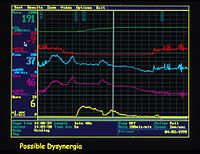
Photo from wikipedia
INTRODUCTION Tibial somatosensory evoked potentials (SEP) are used to identify the neurological status and tethered cord (TC) in patients with spina bifida (SB). Its significance in contributing to the interpretation… Click to show full abstract
INTRODUCTION Tibial somatosensory evoked potentials (SEP) are used to identify the neurological status and tethered cord (TC) in patients with spina bifida (SB). Its significance in contributing to the interpretation of urodynamics to determine bladder status is unknown. This study aimed to determine the correlation between SEP and urodynamics in children with SB. MATERIAL AND METHODS SEP and urodynamic results, for differential diagnosis of TC, were evaluated. SEP scores were correlated with urodynamic findings. SEP results were scored from 1 to 6, with 1, denoting a favorable score and 6, an unfavorable score. Age, gender, detrusor, and sphincter activities in urodynamics were noted. Results were analyzed using the χ2 test and logistic regression analysis. Receiver operating characteristic (ROC) curve was formed to get a valid threshold for the SEP score to predict the urodynamic condition. RESULTS There were 44 SB patients for whom SEP was done for differential diagnosis of TC. Fifteen patients who did not meet the inclusion criteria were excluded from the study. SB aperta was present in 17 patients and occulta in 12, respectively. The patients had a mean age of 6.6 ± 3.2 years. There were 13 boys and 16 girls. A strong correlation was found between high SEP scores and detrusor sphincter dyssynergia (p < 0.001). A SEP score over 3.5 was found to be 93% sensitive and 73% specific to predict this correlation. There was no relationship between detrusor activity and SEP scores (p = 0.18). DISCUSSION Tibial SEP is an important noninvasive adjunct tool for the diagnosis of TC in patients with SB. Urodynamic studies are the gold standard in the evaluation of bladder status in neurogenic bladder dysfunction due to SB. Detrusor sphincter dyssynergia may be regarded as a sign of severe spinal cord injury in these patients. CONCLUSION Our findings suggest that in children with neurogenic bladder, high SEP scores may predict the presence of detrusor sphincter dyssynergia but not the status of detrusor function while providing pathophysiological evidence for neural injury.
Journal Title: Neurourology and urodynamics
Year Published: 2023
Link to full text (if available)
Share on Social Media: Sign Up to like & get
recommendations!